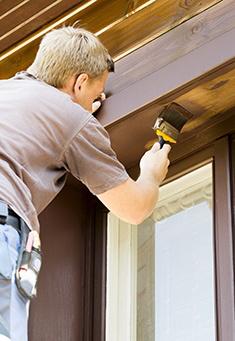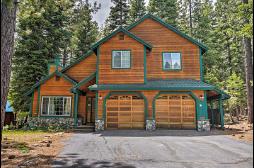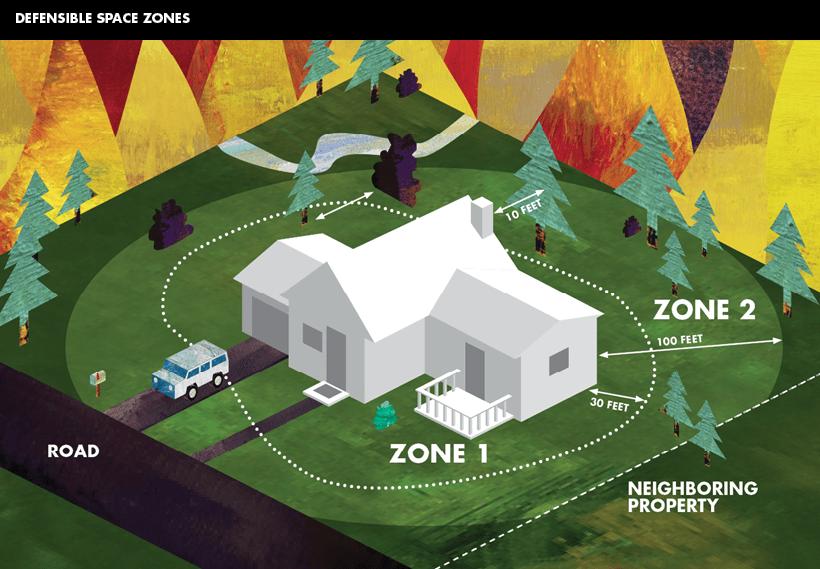
16 minute read
Boost Home Value Before Appraisal
SEPTEMBER 2020 MARKET NEWSLETTER EASTERN PLUMAS & SIERRACOUNTIES Beckwourth, Chilcoot, Clio, Graeagle-Blairsden, Loyalton, Portola & Golf Course Communities of Whitehawk, Grizzly & Gold Mtn.
Boost Your Home's Value Ahead of Your Appraisal
Advertisement
Whether you're planning to sell or refinance, a home appraisal is a necessary step in determining the true value of your home. This means your home should be in the best possible condition, so it will be appraised at the highest potential value. While it may be tempting to swing for the fences with big-ticket renovations, there are smaller things you can do to efficiently raise the market value of your home.

Start Small with a Little Spackle
If you've lived in your home for any length of time, you've probably hung things on the walls, put up shelves, or simply had accidents that resulted in minor damage. Now is the time to repair those blemishes. Filling these holes and crevices with a little spackle and painting over the area will leave your walls looking like new. While this may not boost the value of your home, it will keep theappraiser from deducting for the damage.
As Long as You're Painting...
After you've touched up your walls, you might want to consider freshening up the paint. Repainting worn trim and moldings around the home can give it a fresh look. Venture outside and touch up the trim around the windows and doors too. This will boost curb appeal and help you add value to the home. Any area where the paint is peeling, chipping, or simply has lost its luster should be retouched with a fresh coat.
Update Your Crawl Spaces
An upgrade that's growing in popularity (and will grow your home value) is crawl space encapsulation. Crawl spaces are essential for providing homeowners and contractors with access to important systems of the home. However, these spaces are vulnerable to moisture and water damage caused by humidity and harsh weather conditions. In drier climates, dust and insects can interfere with HVAC systems. To protect crawl spaces, homeowners have started sealing these spaces with polyethylene barriers to keep out moisture, dust, and pests.
Do a Deep Clean
This is also the time to really clean your home from top to bottom. If you have young children and pets, there may be odors and damage that might not be noticeable to you, but strong odors and scuffed hardwood floors will be the first things your appraiser notices. Consider hiring professionals to wax the floors, shampoo the carpets, and conduct an intensive cleaning of the entire home.
Conduct Other Repairs
At some point, you should tour your home with the mindset of a home buyer. This will help you identify problems that you live with every day but just don't notice anymore. Look for things that need to be repaired, such as a loose handrail, a leaky faucet, or a shorted electrical outlet. Repairing these problems ahead of time will ensure you won't lose money on the appraisal.
By taking the time to spruce up the home ahead of the appraisal, you may be able to increase the value by thousands of dollars. The suggestions offered here should give you a head start.
Dickson Portola Team 289 Commercial Street | Portola, CA 96122 | 530.832.1700
SEPTEMBER 2020 MARKET NEWSLETTER EASTERN PLUMAS & SIERRACOUNTIES Beckwourth, Chilcoot, Clio, Graeagle-Blairsden, Loyalton, Portola & Golf Course Communities of Whitehawk, Grizzly & Gold Mtn.


Labor Day –September 7, 2020
Summer’s final fling has arrived in the form of Labor Day. Yes, most of us get the day off, but this holiday triggers mixed emotions. While summer still has 21 calendar days left, it’s time to get serious. School’s starting and there’s a sense that summer vacation is over. So, what’s behind Labor Day —and how did it earn a place as a federal holiday?
Let’s take a look.
WHATIS THE MEANING OF LABOR DAY?
Do you get weekends off work? Lunch breaks? Paid vacation? An eight-hour work day? Social security? If you said “yes” to any of these questions, you can thank labor unions and the U.S. labor movement for it. Years of hard-fought battles (and the ensuing legislation they inspired) resulted in many of the most basic benefits we enjoy at our jobs today . On the first Monday in September, we take the day off to celebrate Labor Day and reflect on the American worker’s contributions to our country.
WHEN IS LABOR DAY?
Labor Day always falls on the first Monday in September, which means anywhere from September 1 through September 7. This year it’s September 7 in the U.S. and Canada —where it’s known as Labour Day. However, this is not the case for most countries —the majority of which celebrate on May 1.
SEPTEMBER 2020 MARKET NEWSLETTER EASTERN PLUMAS & SIERRACOUNTIES Beckwourth, Chilcoot, Clio, Graeagle-Blairsden, Loyalton, Portola & Golf Course Communities of Whitehawk, Grizzly & Gold Mtn.

LABOR DAY HISTORY

There’s disagreement over how the holiday began. One of the versions is set in September 1882 with the Knightsof Labor, the largest and one of the most important American labor organizations at the time. The Knights in New York City held a public parade featuring various labor organizations on September 5 —with the aid of the fledgling Central Labor Union (CLU) of New York. Subsequently, CLU Secretary Matthew Maguire proposed that a national Labor Day holiday be held on the first Monday of each September to mark this successful public demonstration.
In another version, Labor Day in September was proposed by PeterJ. McGuire, a vice president of the American Federation of Labor. In spring 1882, McGuire reportedly proposed a “general holiday for the laboring classes” to the CLU, which would begin with a street parade of organized labor solidarity and end with a picnic fundraiser for local unions. McGuire suggested the first Monday in September as an ideal date for Labor Day because the weather is great at that time of year, and it falls in between July 4th and Thanksgiving. Oregon became the first U.S. state to make it an official public holiday. Twenty-nine other states had joined by the time the federal government declared in a federal holiday in 1894.
"All labor that uplifts humanity has dignity." — Martin Luther King, Jr. "I learned the value of hard work by working hard." — Margaret Mead "Your work is going to fill a large part of your life, and the only way to be truly satisfied is to do what you believe is great work. And the only way to do great work is to love what you do." — Steve Jobs "Rest when you're weary. Refresh and renew yourself, your body, your mind, your spirit. Then get back to work." — Ralph Marston “Without ambition one starts nothing. Without work one finishes nothing. The prize will not be sent to you. You have to win it.” — Ralph Waldo Emerson
Article and quotes courtesy of National Today
SEPTEMBER 2020 MARKET NEWSLETTER EASTERN PLUMAS & SIERRACOUNTIES Beckwourth, Chilcoot, Clio, Graeagle-Blairsden, Loyalton, Portola & Golf Course Communities of Whitehawk, Grizzly & Gold Mtn.

5 Crucial Cold Weather Tips for Preparing Your House for Winter
Our winterizing your home checklist will help you keep your house cozy and safe from winter’s frigid assault.
It's best to winterize your pipes before the snow sets in. But don't fret if you forgot —there are still ways to help keep pipes from bursting, like running your faucets and opening cabinet doors.
Preparing your house for winter may not be on the top of your to-do list right now. After all, most of us wouldn’t rather spend their down time doing home maintenance tasks when they could be enjoying the fall foliage, going apple picking, or sipping pumpkin-spiced lattes instead of winterizing their house. But, here’s the reality: you can’t procrastinate if you want your home to be fully prepared for the winter elements.
Indeed, cold weather, ice, and snow can do real damage to your home —unless you take the time to prepare it before the winter chill takes hold. Completing this checklist will effectively winterize your home — and make your abode a lot more enjoyable when the thermometer dips.
InsulateWindows
Winter drafts can drive up your energy bill —and detract from the cozy vibe you want inside your home when it’s cold outside —if your windows have any air leaks. But by reducing drafts you can lower your home’s energy costs by up to 20% per year, according to the U.S. Energy Department, while also making your living space more comfortable.

Here are five simple solutions (all under $8!) that will allow you toinsulateyourwindows quickly:
1.
2.
3.
4.
5. V-seal weatherstripping. Add this plastic weather stripping along the sides of the sashes. Windows can open and shut evenly with the V-seal in place. (Pro tip: Weather stripping also works wonders on doors.) Ropecaulk. This soft, sticky stuff can be molded to fill the gap —and the caulk removes easily at the end of thecold season. Shrinkfilm. Applied with double-sided tape, this clear plastic sheeting shrinks drum-tight when heated with a hair dryer. The film seals off drafts and captures an insulating buffer of air. Use rubbing alcohol to help release the tape in thespring to avoid stripping off any paint. Nail polish. If carefully applied, clear polish fills the crack almost invisibly. Once hardened, it will stabilize the glass until you can replace it in the spring. Draftsnake. If the bottom of your window is letting in cold air, buy a foam-and-fabric draft snake kit. Cut the 36-inch foam tube provided to length and slip the washable cover over it. Then place the snake on the sill, and shut the window on to seal the deal.
SEPTEMBER 2020 MARKET NEWSLETTER EASTERN PLUMAS & SIERRACOUNTIES Beckwourth, Chilcoot, Clio, Graeagle-Blairsden, Loyalton, Portola & Golf Course Communities of Whitehawk, Grizzly & Gold Mtn.

TrimTreeBranches
The last thing you need is a winter storm loosening the wrath of that mighty tree whose branches are angling over your roof. Not to mention, overhanding limbs can cause excess water to seep into cracks in your home’s roof or siding, which is why you want to make sure any tree limbs or branches surrounding your home are at least 3 feet away from the house.
InspectYourFireplace
A visual inspection, both inside and outside your home, can ensure that your wood-burning fireplaceis in good shape(read: safe) forthe burning season.
During an outdoor inspection, make sure:
A chimney cap is present and in good condition. There is no bird nest or debris buildup on the cap. There are no tree limbs above or near the chimney. The mortar and bricks on the chimney aren’t crumbling or missing. The chimney rises at least 2 feet above where it exits the roof. The chimney crown —the sloping cement shoulders at the top of the chimney —is beveled, which helps air flow. The flue liner is visible above the chimney crown. The chimney is plumb and not leaning to one side or the other.· The roof flashing is tight against the chimney.
Inside your home, confirm that:
The flue damper opens, closes, and seals properly. There are no combustible materials, such as animal nests, or other foreign objects in the flue. The fireplace surround, hearth, and firebox have no cracked bricks or missing mortar.
If you spot any damage, order a professional fireplace and chimney inspection. An inspection costs, on average, between $79 and $500, depending on whether you’re ordering a levelone or level-two inspection. Gas fireplaces require less maintenance, but you should still:
Inspect the glass doors for cracks or latch issues. Check that the gas logs are in the proper position. Turn gas off at the shut-off valve and test the igniter. Ignite the fire and look for clogged burner holes. If present, turn off gas and clear obstructions with a pin or needle.
Check the Roof
You certainly don’t want to find out you have a leaky roof afterthe first snow hits. A roof inspection can help you spot any potential issues.
Squeamish about heights? Don't worry —you can do a thorough inspection from the ground using a pair of binoculars.
Work your way around your house, looking for these defects:
Cracked caulk or rust spots on flashing. Shingles that are buckling, curling, or blistering. Missing or broken shingles. Cracked and worn rubber boots around vent pipes. Masses of moss and lichen, which could signal the roof is decaying underneath. Black algae stains are just cosmetic.
Some roofing fixes are easy to do yourself, such as repairing shingles or calking flashing, if you’re comfortable working on a roof. If you’re not, you’ll want to consult a specialized roof inspector. Be prepared to pay between $119 and $296 for a standard roof inspection.
ClearOutGutters and Downspouts
Clogged rain gutters or downspouts can damage your home’s foundation or cause ice dams, which can lead to expensive repairs. So, after the leaves have fallen, clean yourguttersto remove leaves, twigs, and gunk. Also, make sure the gutters aren’t sagging and trapping water, tighten gutter hangers and downspout brackets, and replace any worn or damaged materials.
SEPTEMBER 2020 MARKET NEWSLETTER EASTERN PLUMAS & SIERRACOUNTIES Beckwourth, Chilcoot, Clio, Graeagle-Blairsden, Loyalton, Portola & Golf Course Communities of Whitehawk, Grizzly & Gold Mtn.

Keep Your Property Lean And Green To Help Protect Your Family And Home.
Creating defensible space is essential to improve your home’s chance of surviving a wildfire. It’s the buffer you create between a building on your property and the grass, trees, shrubs, or any wildland area that surround it. This space is needed to slow or stop the spread of wildfire and it protects your home from catching fire—either from direct flame contact or radiant heat. Defensible space is also important for the protection of the firefighters defending your home.
Defensible Space Zones
Two zones make up the required 100 feet of defensible space

Zone 1
Zone 1 extends 30 feet* out from buildings, structures, decks, etc. • Remove all dead plants, grass and weeds (vegetation). • Remove dead or dry leaves and pine needles from your yard, roof and rain gutters. • Trim trees regularly to keep branches a minimum of 10 feet from other trees. • Remove branches that hang over your roof and keep dead branches 10 feet away from your chimney. • Relocate wood piles into Zone 2. • Remove or prune flammable plants and shrubs near windows. • Remove vegetation and items that could catch fire from around and under decks. • Create a separation between trees, shrubs and items that could catch fire, such as patio furniture, wood piles, swing sets, etc.
Zone 2
Zone 2 extends 100 feet out from buildings, structures, decks, etc. • Cut or mow annual grass down to a maximum height of 4 inches. • Create horizontal spacing between shrubs and trees. (See diagram) • Create vertical spacing between grass, shrubs and trees. (See diagram) • Remove fallen leaves, needles, twigs, bark, cones, and small branches. However, they may be permitted to a depth of 3 inches.
SEPTEMBER 2020 MARKET NEWSLETTER EASTERN PLUMAS & SIERRACOUNTIES Beckwourth, Chilcoot, Clio, Graeagle-Blairsden, Loyalton, Portola & Golf Course Communities of Whitehawk, Grizzly & Gold Mtn.

HARDENING YOUR HOME Flying embers can destroy homes up to a mile from a wildfire. “Harden” your home now before a fire starts by using ember-resistant building materials. Here are some things you can do to harden your home and make it more fire resistant. Roof
The roof is the most vulnerable part of your home. Homes with wood or shingle roofs are at high risk of being destroyed during a wildfire. Build your roof or re-roof with materials such as composition, metal or tile. Block any spaces between roof decking and covering to prevent embers from catching.
Vents
Vents on homes create openings for flying embers. Cover all vent openings with 1/8-inch to 1/4-inch metal mesh. Do not use fiberglass or plastic mesh because they can melt and burn. Protect vents in eaves or cornices with baffles to block embers (mesh is not enough).
Eaves and Soffits
Eaves and soffits should be protected with ignitionresistant* or non-combustible materials.
Windows
Heat from a wildfire can cause windows to break even before the home ignites. This allows burning embers to enter and start fires inside. Single-paned and large windows are particularly vulnerable. Install dual-paned windows with one pane of tempered glass to reduce the chance of breakage in a fire. Consider limiting the size and number of windows that face large areas of vegetation.
Walls
Wood products, such as boards, panels or shingles, are common siding materials. However, they are combustible and not good choices for fire-prone areas. Build or remodel your walls with ignition resistant* building materials, such as stucco, fiber cement, wall siding, fire retardant, treated wood, or other approved materials. Be sure to extend materials from the foundation to the roof.
Decks
Surfaces within 10 feet of the building should be built with ignition-resistant*, non-combustible, or other approved materials. Ensure that all combustible items are removed from underneath your deck.
Rain Gutters
Screen or enclose rain gutters to prevent accumulation of plant debris.
Patio Cover
Use the same ignition-resistant* materials for patio coverings as a roof.
Chimney
Cover your chimney and stovepipe outlets with a non-combustible screen. Use metal screen material with openings no smaller than 3/8-inch and no larger than 1/2-inch to prevent embers from escaping and igniting a fire.
Garage
Have a fire extinguisher and tools such as a shovel, rake, bucket, and hoe available for fire emergencies. Install weather stripping around and under the garage door to prevent embers from blowing in. Store all combustible and flammable liquids away from ignition sources.
Fences
Consider using ignition-resistant* or noncombustible fence materials to protect your home during a wildfire. Driveways and Access Roads Driveways should be built and maintained in accordance with state and local codes to allow fire and emergency vehicles to reach your home. Consider maintaining access roads with a minimum of 10 feet of clearance on either side, allowing for two-way traffic. Ensure that all gates open inward and are wide enough to accommodate emergency equipment. Trim trees and shrubs overhanging the road to allow emergency vehicles to pass.
Address
Make sure your address is clearly visible from the road.
Water Supply
Consider having multiple garden hoses that are long enough to reach all areas of your home and other structures on your property. If you have a pool or well, consider getting a pump.


